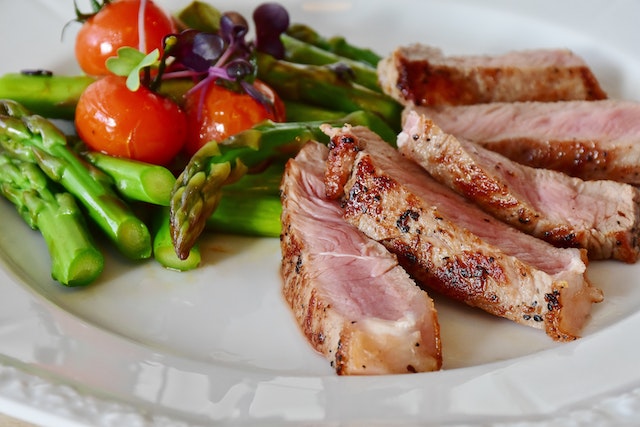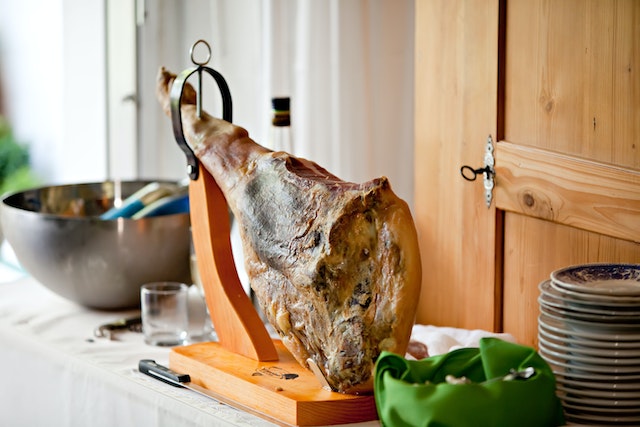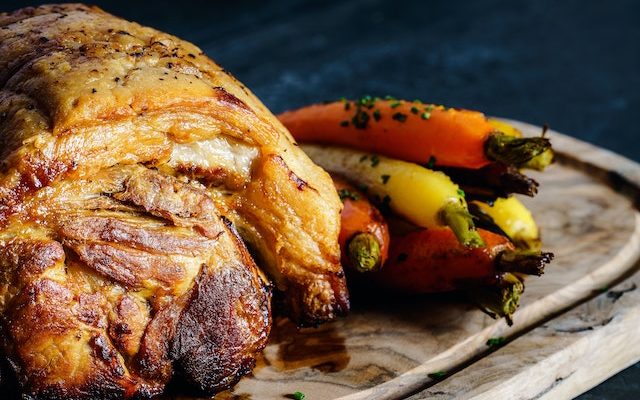As a customer looking for the right type of pork to cook up in the kitchen, it’s no surprise that you may find yourself faced with the common conundrum: pork butt vs pork shoulder? Both are cuts from the same animal, but they each have their own unique features and benefits that make them great choices for different types of dishes. In this blog post, we’ll be breaking down what makes these two cuts distinct and discussing which one might be better suited to your particular cooking needs. So, whether you’re grilling out back or baking up some BBQ in the oven – let’s get started talking about why pork butt and pork shoulder are so different!
Table of Contents
What Is A Pork Butt?
A pork butt, also known as a Boston Butt or shoulder butt, is a cut of pork that comes from the upper part of the pig’s shoulder. It is usually sold bone-in, but can sometimes be found boneless. This cut contains a lot of fat and connective tissue, which makes it perfect for slow cooking methods such as smoking or roasting.
Pork butt has become popular in recent years due to its versatility and ability to be used in various recipes. It is ideal for dishes like carnitas and pulled pork sandwiches, as it can easily be shredded once cooked. This cut can also be used to make sausage, as it contains enough fat to bind the ingredients together when ground.
In addition to being used for cooking, pork butts are also great for curing and making charcuterie. The high fat content allows for the meat to be cured quickly and have a distinct flavor when smoked or air-dried. It is especially popular among chefs who want to make their own salami or cured meats at home.
The name “pork butt” originates from Colonial America, where farmers would send their pigs’ shoulders off in barrels that were labeled with the tag “Boston Butt”. As time went on, the term became more widely used throughout North America as an alternative name for this same cut of meat.
Overall, pork butt is an incredibly versatile cut of meat that works well in almost any recipe. From pulled pork sandwiches to homemade charcuterie, this rich and flavorful cut can take your cooking game up a notch!
What Are Some Of The Best Pork Butt Recipes?

Pork Butt, also known as Boston Butt, is a cut of pork that comes from the upper part of the shoulder. It is generally quite a tough cut of meat, which makes it perfect for slow cooking. Slow braising or smoking are two of the best techniques for cooking pork butt and when cooked properly, it can be incredibly succulent and juicy with a rich flavor.
One of the classic recipes for pork butt is pulled pork. To make pulled pork, rub the surface of the pork butt with your favorite seasoning mix. Then place the seasoned pork in slow cooker or Dutch oven with some liquid such as beer or stock to prevent it from drying out. Cook on low heat for several hours until it is tender enough that you can pull apart the meat with two forks. Serve your pulled pork on buns with coleslaw and barbecue sauce for an amazing sandwich experience!
Another delicious recipe for pork butt is Cuban-style Mojo Pork. To prepare this dish, marinate a boneless pork butt overnight in a mixture of garlic, citrus juice (like orange juice), cumin, oregano and parsley. Place the marinated pork into an oven proof dish and pour in some additional citrus juice before covering and baking in a preheated oven at 350F (180C) until tender (around 2 – 3 hours). Shred the cooked meat and serve with rice, black beans, plantains or any other sides of your choice – delicious!
If you’re looking to impress guests at your next get together then why not try making Smoked Pork Butt? Trim off any excess fat from around the roast before rubbing it down liberally with a homemade dry rub made up of seasonings like paprika, garlic powder, thyme and brown sugar. Place your roast onto smoker racks to ensure even cooking across all sides – cook over low indirect heat for 5 – 6 hours until it has reached an internal temperature of 190F (88C). Once done rest for 15 minutes before shredding or slicing thinly to serve – yum!
No matter which recipe you choose you can be sure that your Pork Butt will turn out deliciously tender and packed full of flavor when cooked correctly. So if you’re looking to add some excitement to your next meal why not give one (or all!) these tasty recipes a try?
What Is Pork Shoulder?
Pork shoulder, also known as pork butt, is an incredibly versatile cut of meat that comes from the shoulder of a pig. It’s one of the most commonly used cuts in many types of cuisine around the world. Pork shoulder is a relatively fatty cut with a good amount of marbling and connective tissue, which makes it perfect for slow-cooking techniques like braising or smoking. This cut can be used for traditional dishes like pulled pork, carnitas, and bacon, but can also be used to make stews, roasts, and soups.
When cooked properly, pork shoulder is extremely tender and juicy with a deep flavor that comes from the fat content in the meat. The fat content helps create a rich flavor when cooked slowly at low temperatures or even over an open flame. Smoking or barbecuing pork shoulder results in the classic sweet-savory balance that is so popular with barbecued meats. The flavorful fat also allows you to cook pork shoulder quickly without drying out the meat.
Particularly popular in Latin American cuisines such as Mexican and Cuban, pork shoulder is often used to make tacos al pastor – thinly sliced pieces of pork marinated overnight with spices and served atop tortillas along with onions and cilantro. In Colombia, it’s fried until crisp before being tossed into empanadas or arepas (corn breads). In Korea, it’s typically treated to an overnight marinade featuring soy sauce, garlic cloves and ground black pepper before being grilled or skillet-cooked. And in many parts of Europe–particularly Spain–it’s sometimes slow-cooked until succulent then served as part of paella recipes or other rice dishes.
Whether you decide to smoke this cut for hours on end for traditional meals like pulled pork sandwiches or just roast it quickly for tacos al pastor – one thing is certain: Pork Shoulder will bring bold flavors to any recipe you choose!
What Are Some Of The Best Pork Shoulder Recipes?

Pork shoulder is an incredibly versatile cut of meat, making it a great choice for chefs who are looking to whip up some delicious dishes. Whether you’re looking for something slow-smoked, braised, or roasted, there are plenty of wonderful pork shoulder recipes out there to choose from.
One of the most popular pork shoulder recipes is pulled pork. This classic dish calls for a whole pork shoulder to be slowly cooked over indirect heat until it’s tender and juicy. Once it’s done cooking, the meat can be pulled apart with two forks and served on a bun or in tacos. To take this dish to the next level, try adding in your favorite BBQ sauce or spices before serving.
For a unique twist on barbecue, consider giving Chinese-style char siu pork shoulder a try. This fragrant dish features succulent pieces of roasted pork shoulder that have been marinated in a combination of garlic, soy sauce, rice wine vinegar and five spice powder. Serve it alongside steamed buns or white rice for an amazing meal that will leave your taste buds delighted.
If you’re looking to make something truly special with your pork shoulder, why not try preparing cochinita pibil? This traditional Mexican dish involves braising the pork shoulder with annatto paste and orange juice until it becomes irresistibly tender and flavorful. Wrap the cooked meat in banana leaves before baking it in the oven – the end result is an unforgettable meal that’s sure to be enjoyed by everyone at the table!
No matter what type of recipe you’re planning on making, make sure to always purchase responsibly sourced ingredients whenever possible. Make sure that your local butcher carries humanely raised and ethically slaughtered meats – this will ensure that you get top quality ingredients every time!
Pork Butt vs Pork Shoulder Comparison
When it comes to choosing the right cut of pork for your favorite recipes, there is much debate about whether pork butt or pork shoulder is better. Both cuts of meat come from the same area of the hog, the shoulder, but there are some differences that set them apart.
Pork butt is also referred to as “Boston Butt” or “Shoulder Butt” and comes from the upper part of the shoulder of a hog. It has a higher fat content which gives it more marbling and makes it an ideal cut for slow cooking methods such as braising and roasting. Pork butt is usually sold in larger pieces than other cuts and can be used to make pulled pork, stews, chilis and more.
Alternatively, pork shoulder (also called “Picnic Shoulder”) comes from the lower part of the hog’s shoulder and has less fat than its counterpart. Its leaner texture makes it perfect for dishes that require long, slow cooking such as simmering in sauces or shredded into tacos. This cut is often made into roasts, sausages and smoked dishes like bacon or ham.
When comparing these two cuts side by side, pork butt has a richer flavor due to its higher fat content while pork shoulder has a milder flavor because of its leaner texture. Additionally, since pork butt contains more connective tissue it requires longer cooking times than pork shoulder does in order to break down those tissues for tenderness. On the other hand, when cooked properly, both types of meat can be juicy and flavorful.
In terms of cost effectiveness, both options are relatively inexpensive as compared to other cuts of meat; however, since pork butt contains more fat it may be slightly pricier than pork shoulder depending on where you purchase it from.
Pork Butt vs Pork Shoulder? Overall, both types of meat can offer delicious dishes with their own unique flavors when cooked properly; however they should not be substituted interchangeably as they cook differently based on their fat content and connective tissue composition. Whether you choose to go with pork butt or pork shoulder for your dish depends on your tastes preferences and budget – just remember that no matter which cut you use taking time to cook it low-and-slow will yield tender results every time!
>>> You might also like:
Best Indoor Smokeless Grill Consumer Reports
FAQs About Pork Butt vs Pork Shoulder
How Do You Cook Pork Butts?
Pork butts can be cooked in many different ways. Grilling over indirect heat produces an incredibly flavorful product when seasoned with your favorite rub or marinade prior to cooking. Slow cooking with liquid smoke adds another dimension of flavor to any recipe. Braising in liquid creates an ultra-tender texture for pulled pork sandwiches or tacos. Smoking over low heat for several hours tenderizes the meat while adding smoky nuances that deepen the overall flavor profile significantly. No matter which method you choose, always make sure to bring your pork butts up to at least 145°F internal temperature when serving to ensure food safety before enjoying!
What Type Of Seasoning Should I Use On My Pork Butts?

Pork butts are incredibly versatile and can take just about any type of seasoning you might like! If grilling, try using coarsely ground black pepper and salt as a simple base before adding other flavors like garlic powder, paprika, oregano, turmeric or brown sugar for an added boost of flavor and sweetness. For slow cooking or smoking applications try adding in hickory smoked salts along with garlic powder and onion powder for a subtle smokiness that won’t overpower your dishes’ flavors!
How Long Does It Take To Cook Pork Butts?
Depending on whether you’re grilling, slow cooking or smoking your pork butt will affect how long it takes to cook through properly. Generally speaking if you are grilling over medium direct heat (350°F) about 30 minutes per pound should do the trick; if slow cooking start at 8 hours on low heat; and if smoking plan for 1 – 2 hours per pound at 225°F depending on how tender you’d like your final product to be!
Where Does Pork Shoulder Come From?
Pork shoulder is typically sourced from the front legs of the pig. The meat at this location contains more fat than cuts from other parts of the animal, which lends to its tenderness and flavor.
How Should I Prepare Pork Shoulder?
There are many different ways to cook pork shoulder – grilling or smoking are popular cooking methods due to their ability to impart smoky flavors and crispiness to the outside of the meat while keeping the inside moist and juicy. Roasting in an oven or braising in liquid are great options as well.
What Temperature Should I Cook Pork Shoulder?
For most recipes, you will want to cook your pork shoulder until it reaches an internal temperature of 145°F (63°C). When using low-and-slow cooking techniques like braising or smoking, however, you can cook your meat until it reaches an internal temperature between 165 – 185°F (74 – 85°C). This extended cooking time allows for more tenderness and juiciness throughout the entire cut.
Are There Any Health Benefits Associated With Eating Pork Shoulder?
Yes! Pork shoulder is a great source of lean protein that provides essential vitamins and minerals such as iron, zinc and B vitamins. It also contains heart-healthy monounsaturated fats that can help reduce cholesterol levels in your body. Furthermore, because it’s packed with protein it helps keep you feeling full longer.
>>> See more: Slow Roasted Pork Shoulder – Wicked Good Eats (Pork Butt vs Pork Shoulder: It’s Time to Understand the Difference)
Conclusion
The next time you’re at the grocery store debating which pork product to buy, remember these key points: Pork butt comes from the upper part of the shoulder while pork shoulder comes from the lower portion. Pork butt is well-marbled and contains more fat than pork shoulder, making it more flavorful. However, because it has more fat, it also takes longer to cook. Pork shoulder is leaner and therefore quicker to cook but doesn’t have as much flavor. When deciding which one to buy, consider how you will be cooking it and what flavors you want to incorporate into your dish.
Pork Butt vs Pork Shoulder? Welcome to the Cafe Toscana Restaurant blog! Here we’ll be sharing all the latest news and information about our delicious Tuscan-inspired cuisine. Stay up to date on our latest specials and events, and get tips and tricks for recreating that Toscana flavor at home. Thanks for reading and buon appetito!

